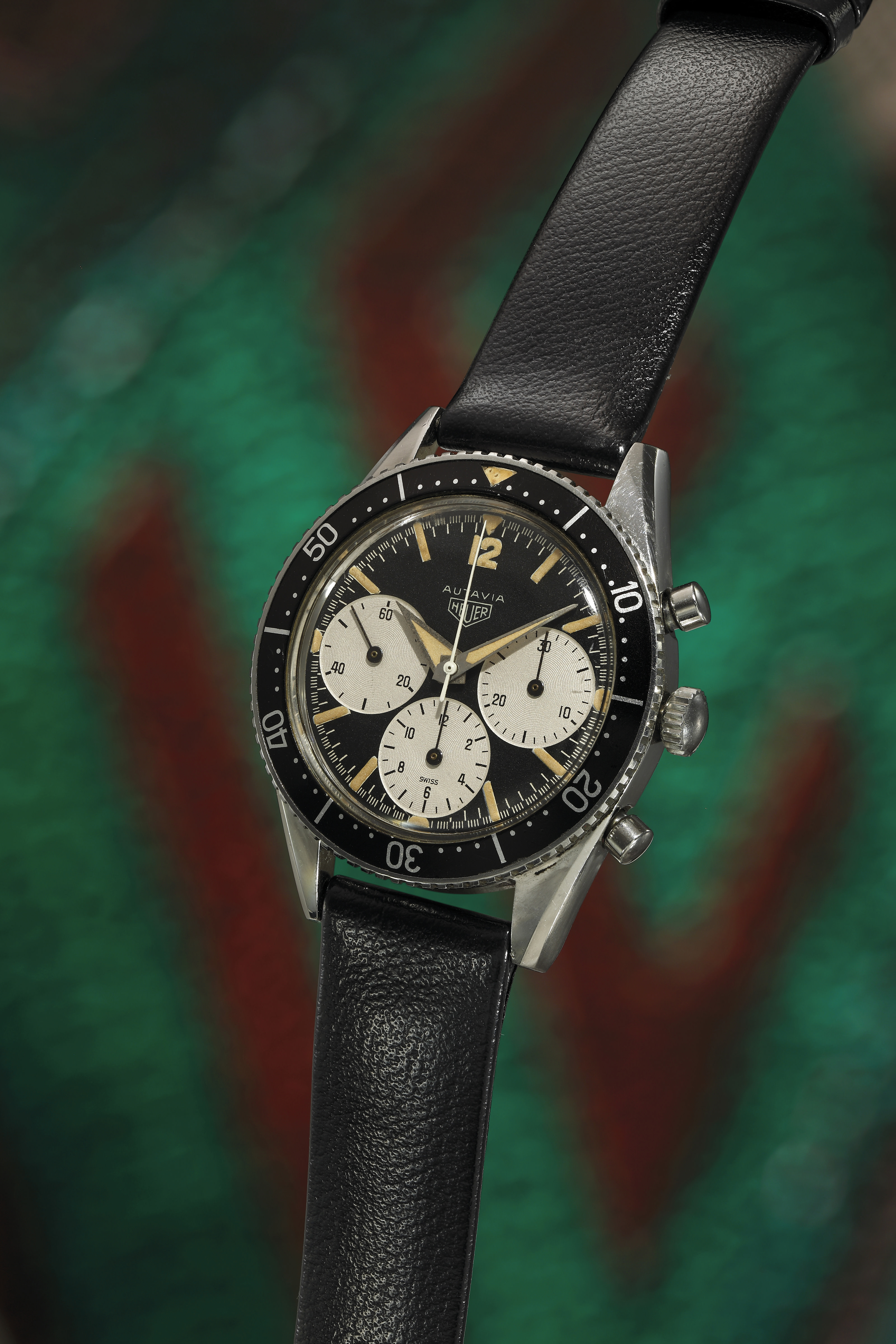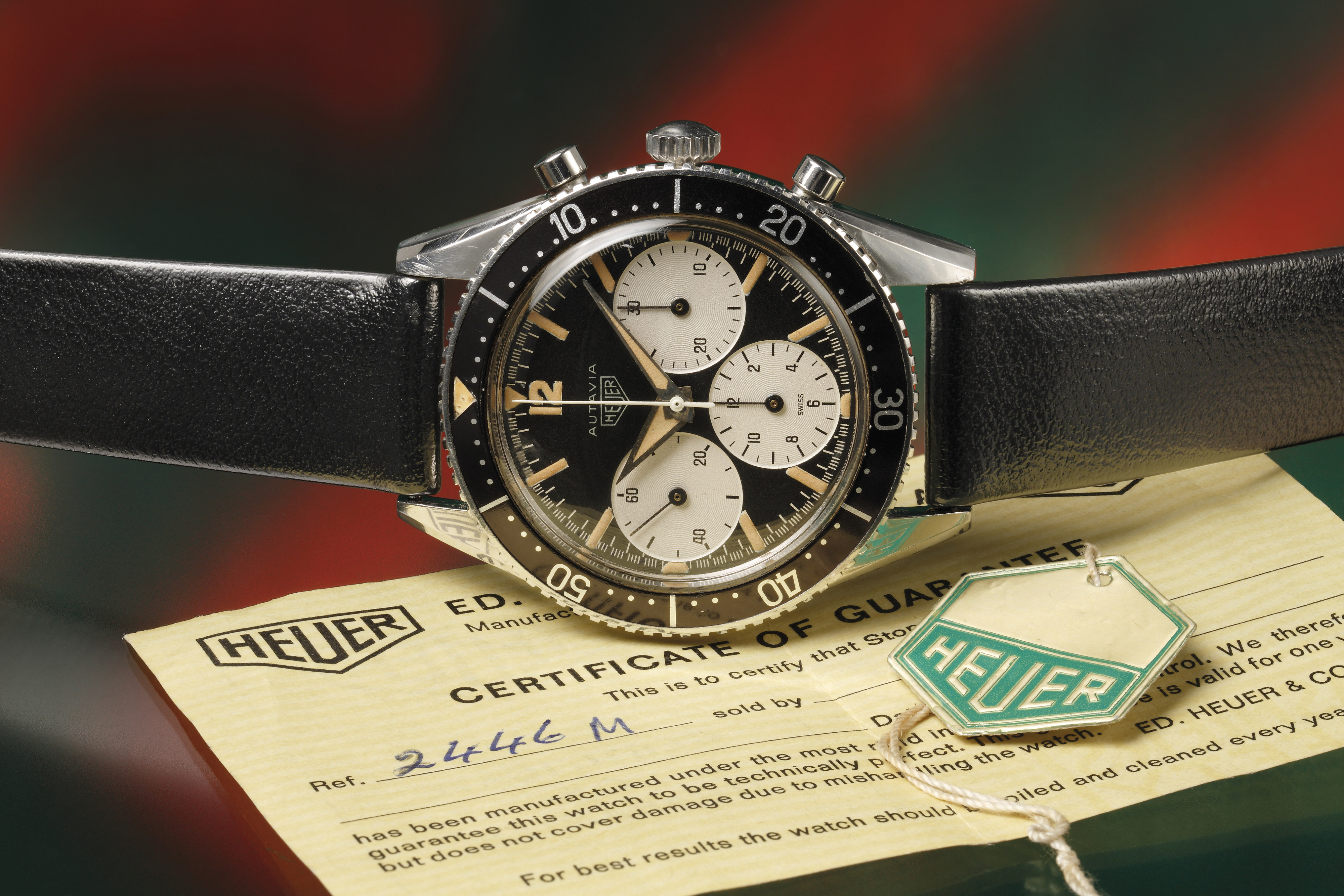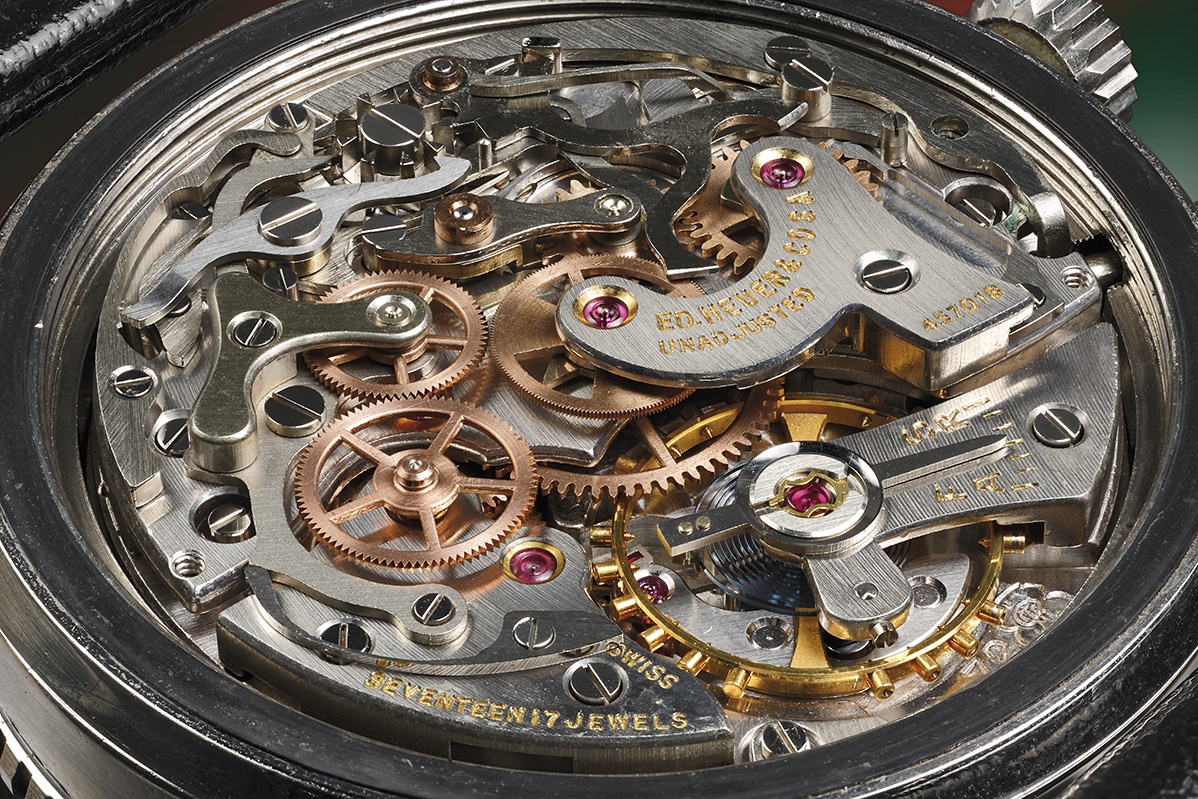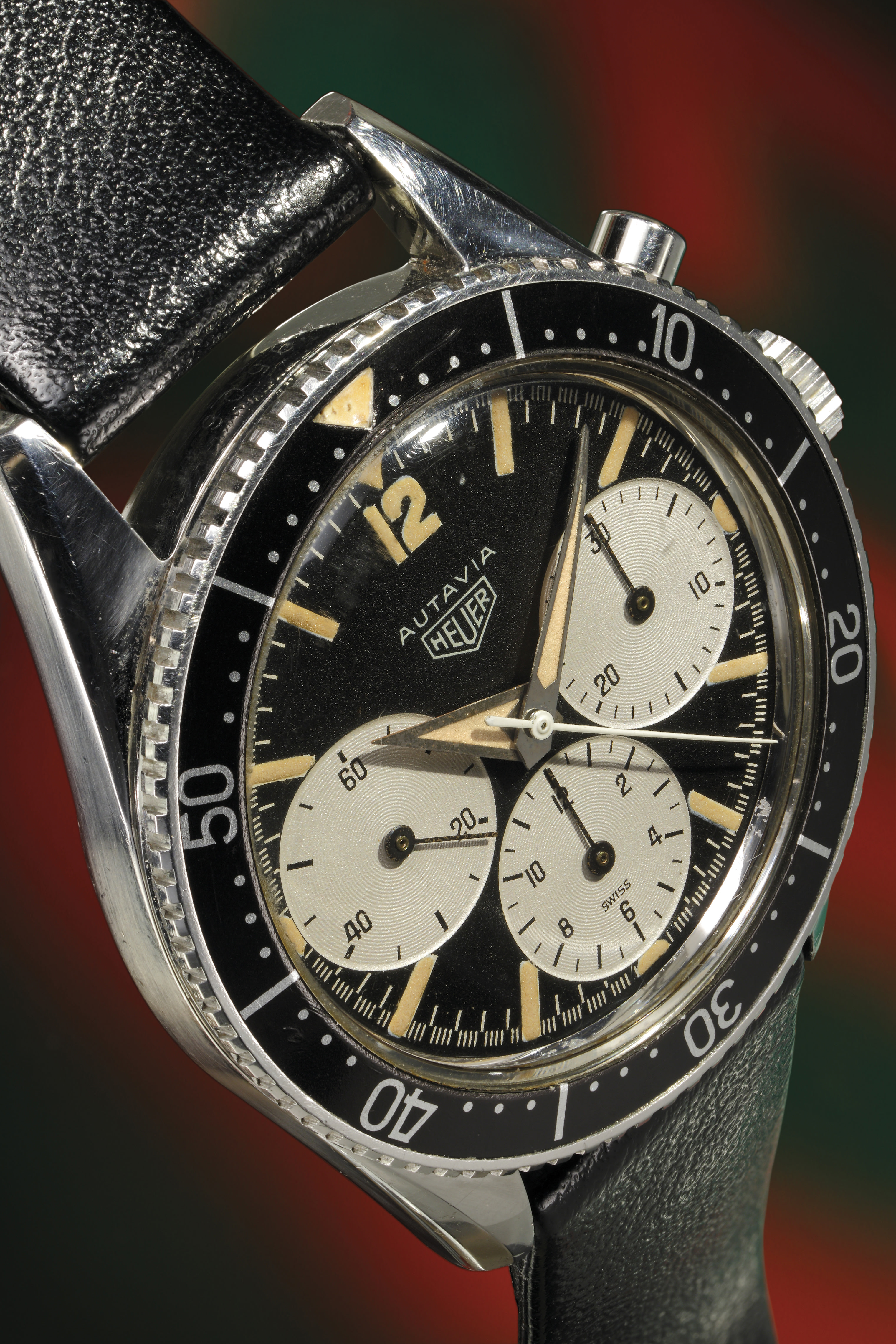









3
Heuer
Ref. 2446M
Autavia 'Big Sub', 1st execution dial , 2nd execution hands
An extremely rare and fine stainless chronograph wristwatch with big subsidiary dials and large bezel accompanied by Original Certificate of Guarantee.
- Estimate
- CHF80,000 - 120,000
CHF137,500
Lot Details
- Manufacturer
- Heuer
- Year
- 1962
- Reference No
- 2446M
- Movement No
- 457'018
- Case No
- 49'506
- Model Name
- Autavia 'Big Sub', 1st execution dial , 2nd execution hands
- Material
- Stainless steel
- Calibre
- Manual, cal. Valjoux 72, 17 jewels
- Bracelet/Strap
- Original Heuer Corfam strap
- Clasp/Buckle
- Stainless steel Heuer "sun" buckle
- Dimensions
- 39mm. Diameter
- Signed
- Case, dial, movement and buckle signed
- Accessories
- Accompanied by the Original Certificate of Guarantee confirming date of sale of the present watch on August 5th, 1963 and Heuer swing tag.
Specialist
Full-Cataloguing
Catalogue Essay
A regular in the pit lanes, Jack Heuer knew all too well the importance of accurate timekeeping. The dashboard watches of the late 1 950s, that he had developed, were already a great improvement with their larger minute hand and much larger digits. However, the Jack of legibility and his subsequent misread on the Autavia dashtimer cost him a race win in a local rally event. This event was detrimental in the designs of the chronographs he was planning on launching. Their smaller size meant that the features on the dial had to be even clearer and crisper so that there could be no timing discrepancies. The first series Autavias, from the early 1960s, thus had oversize starkly contrasting registers and often, as with this lot, large Dauphine hands (luminous fi/led, as are the numerals and bezel. The presence of a particular rotating bezel, such as in this case a minute bezel, made this chronograph the perfect tool watch.
The present watch also sports the earlier Mark 1 "small" pushers and a domed crown, which were fitted to the early batches, but have often been lost or changed at service. Other early features are the Ed. Heuer signed movement and caseback with individual movement number.
In the autumn of 1961 Jack Heuer, alongside his production team, decided to create the Autavia (the name coming from a combination of the words Automobile and Aviation) as their first named chronograph series. Prior to that point they had not made a chronograph wristwatch with a turning bezel and the Autavia would have this new feature on both models (round and tonneau cases) with a choice of division markers. Two types of bezels were available, one with 60 separate one-minute divisions, that would allow the wearer to set a marker for a defined interval of Jess than one hour and another with a 12-hour division that would allow the time in another time zone to be displayed.
The first Heuer advertising brochure from 1 962 shows bath the reference 2446 and the reference 3646 under the title "New AUTAVIA Chronographs for pilots, sportsmen, divers and scientists'; showing that Heuer was promoting the collection across all spectrums and trying to appeal to all markets. A wonderful quote from the brochure states, "Guaranteed to function perfectly at altitudes up to 35, 000 feet or depths of 330 feet underwater': This attitude of making robust tool watches, which were fit for many purposes, was to become the building blacks of the Heuer range.
The current demand for the early Autavias has never been stronger and collectors are realiz1ng how rare examples like this present first execution watch are in comparison to other great chronographs from the same era which share the same Valjoux 72 movement.
Over the past 10 years, only a handful has appeared on the international auction market, let alone in this truly outstanding condition. Not only is th1s example in the finest condition, it may also be the most complete and original piece yet seen on the market. This timepiece with its vivid modern looks and powerful design proudly embodies the genetic template of the Autavia. It is featured prominently in the Heuer Autavia Chronographs 1962-85 book by Richard Crosthwaite & Paul Gavin.
The present watch also sports the earlier Mark 1 "small" pushers and a domed crown, which were fitted to the early batches, but have often been lost or changed at service. Other early features are the Ed. Heuer signed movement and caseback with individual movement number.
In the autumn of 1961 Jack Heuer, alongside his production team, decided to create the Autavia (the name coming from a combination of the words Automobile and Aviation) as their first named chronograph series. Prior to that point they had not made a chronograph wristwatch with a turning bezel and the Autavia would have this new feature on both models (round and tonneau cases) with a choice of division markers. Two types of bezels were available, one with 60 separate one-minute divisions, that would allow the wearer to set a marker for a defined interval of Jess than one hour and another with a 12-hour division that would allow the time in another time zone to be displayed.
The first Heuer advertising brochure from 1 962 shows bath the reference 2446 and the reference 3646 under the title "New AUTAVIA Chronographs for pilots, sportsmen, divers and scientists'; showing that Heuer was promoting the collection across all spectrums and trying to appeal to all markets. A wonderful quote from the brochure states, "Guaranteed to function perfectly at altitudes up to 35, 000 feet or depths of 330 feet underwater': This attitude of making robust tool watches, which were fit for many purposes, was to become the building blacks of the Heuer range.
The current demand for the early Autavias has never been stronger and collectors are realiz1ng how rare examples like this present first execution watch are in comparison to other great chronographs from the same era which share the same Valjoux 72 movement.
Over the past 10 years, only a handful has appeared on the international auction market, let alone in this truly outstanding condition. Not only is th1s example in the finest condition, it may also be the most complete and original piece yet seen on the market. This timepiece with its vivid modern looks and powerful design proudly embodies the genetic template of the Autavia. It is featured prominently in the Heuer Autavia Chronographs 1962-85 book by Richard Crosthwaite & Paul Gavin.
Literature
Heuer
Swiss | 1860This iconic chronograph manufacturer has a long tradition of precision timekeeping. As early as 1882, founder Edouard Heuer held a patent for a chronograph watch; in 1887, he received a patent for an oscillating pinion, which is still in use today. These specialized timepieces have been at the heart of the firm's success, enabling the brand to be chosen as early timekeepers for the Olympics. In 1969, the company introduced their first automatic chronograph watch, the Monaco Heuer, which celebrated the Monaco Grand Prix. Other key chronograph models include the Autavia and the Carrera, all of which having become iconic models of the firm.
Browse Maker